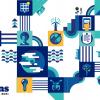
The concept of systems analysis is difficult to pin down, but in fact, the flexible, shapeshifting nature of this discipline turns out to be its superpower.
Systems analysis is an immensely powerful way to bring scientific insights into policy, but it is not easy to define. Any brief phrase aiming to encapsulate the discipline is liable to be incomplete. So instead of a definition, here is a description, with deliberately fuzzy edges:
Systems analysis is a set of approaches for solving complex problems.
It is, of course, about systems. A system is any set of interacting components, such as species in an ecosystem or traders in a market. Even apparently simple systems with just a few components can do surprising things, as feedback loops lead to unpredictable behavior.
Many tools can be used to get to grips with the behavior of systems. They include formal ways to define and discuss problems, and an array of mathematical modeling techniques.
In applied systems analysis, the aim is not just to understand a system, but to suggest how to change it. At IIASA, systems tools are used to support decision making, bringing the insights of systems science into policy, to address the complex problems of the real world such as pollution, deprivation, and climate change.
HOLISTIC DETECTION
Systems analysis gains much of its power from recognizing that systems are not isolated. For example, the climate, the economy, and the biosphere all affect one another, forming a global system of systems. With such a holistic view, systems analysis can tackle problems that are rooted in several different systems.
That enables it to identify:
- Trade-offs, for example between wealth and biodiversity
• Unintended consequences, such as biofuels causing carbon emissions through indirect land-use change
• Co-benefits, where one action improves two outcomes, such as electric vehicles mitigating both climate change and pollution
• Synergies, where two or more actions achieve something that no single action could accomplish
This broad and flexible perspective also helps to reveal solutions. Instead of trying to solve a problem by tinkering with one narrow system, you can take a step back and include other areas – creating a system big enough to include the solution. Treating climate change as a physical problem alone may not suggest a practical policy, but if you include economics and social sciences, you bring in the incentives and institutions that can make a difference.
MODEL ROLES
The institute’s mathematical arsenal includes optimization models, agent-based models, statistical models, game-theoretic models, and many other model types used in various combinations to deal with climate, energy, and pollution; food and water; natural disasters; economy and demography.
Where several different goals compete, optimization models can help to find a balance. A highly successful example is the IIASA air pollution model, originally known as the Regional Air Pollution Information and Simulation Model (RAINS). In the 1990s, RAINS helped to guide Europe’s policy on six pollutants, including particulates and sulphur dioxide (the chief cause of acid rain), calculating costs and health effects of various policies. RAINS results in Europe and India have shown the power of cooperative action on air pollution, which is much more effective than efforts by any single state, and therefore more politically attractive. Now extended to include greenhouse gases, the Greenhouse Gas and Air Pollution Interactions and Synergies (GAINS) Model reveals how clean-air policies can have co-benefits, improving the health of people and ecosystems while also curbing climate change.
The mathematics behind these models is constantly being developed to deal with new situations and complexities. New sources of data, such as crowdsourcing and novel sensors, are feeding in, and models in different areas are being linked together, to reflect real-world links between systems such as climate and the biosphere.
HUMAN VALUES
The aim of all this analysis is to steer systems in the right direction. But what is the right direction? Right for whom? On top of that, the shape of social systems is constantly changing, making them hard to navigate.
To provide both a moral compass and societal map, systems analysis takes a human-centered approach, engaging with diverse viewpoints.
The soft systems methodology provides one way to do this. It is a formal process with several stages, but the essence is to bring people together to sketch out a system, identify goals and possible actions, and then model the system to find out what each action would do. That may involve a causal loop diagram, laying out how the system’s components are connected to reveal critical feedbacks. The whole process is often iterative, with one round of analysis producing insights to inform the next round.
Sometimes this can lead to a consensus that satisfies everyone. It can help solutions to stick, because people that have participated in a process are much more likely to trust its outcomes and support action.
Other times, people are implacably opposed, but even then, developments in systems analysis are making progress possible. By acknowledging that even diametrically opposed worldviews can be equally valid, it can turn a stalemate into a compromise. In Nocera Inferiore in Southern Italy, conflicting views on how to deal with the risk of landslides had stymied any action. One group favored natural solutions such as tree planting; the other favored artificial barriers. From 2010 to 2013, IIASA led a participatory process with experts and participants working together to generate solutions for each opposing view, rather than imposing an expert-preferred solution. The groups eventually negotiated a mixed approach.
So systems analysis is an infinitely adaptable multi-tool, transforming to fit the particular complexity of each subject. It can shift perspectives: embracing different physical systems, disciplines, scales, and viewpoints – giving it a unique ability to grapple with the fiendishly difficult problems posed by today’s fast-changing and increasingly interconnected world.
By Stephen Battersby


